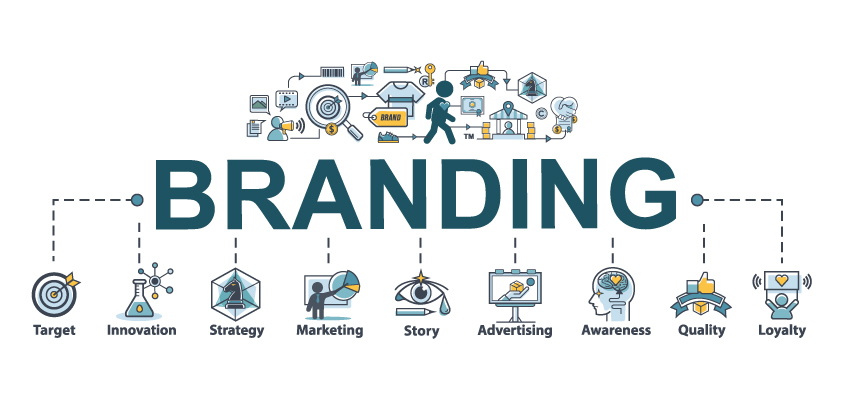The Trick to Structure Client Trust Hinges On Robust Branding
The Trick to Structure Client Trust Hinges On Robust Branding
Blog Article
Building Durable Branding for Long-Term Business Success
A cohesive brand name identification not just distinguishes a business from its rivals yet likewise grows trust and commitment among customers. What methods can organizations employ to not just create a remarkable brand but also receive its relevance over time?
Comprehending Brand Identification
Brand name identification offers as the foundation of a company's picture and credibility, encompassing components such as logo design, shade combination, messaging, and typography. Each element plays an essential role in creating a natural and well-known brand that reverberates with its target audience. A properly designed logo works as an aesthetic representation of the brand's worths and goal, while a carefully selected shade scheme stimulates details emotions and organizations.
Typography additionally contributes significantly to brand name identity; the selection of typeface can affect perceptions of professionalism and reliability, dependability, or creativity. Consistency in these components cultivates familiarity, enabling consumers to rapidly recognize and connect with the brand in different contexts.
Moreover, messaging is equally crucial, as it interacts the brand name's core values and differentiators. Clear and compelling messaging aids establish a solid narrative that develops and engages clients trust.
Eventually, a well-defined brand identification not only boosts visibility yet also cultivates commitment amongst customers. By spending time and sources into establishing a durable brand name identification, organizations can create an enduring impact that supports long-term development and success.
Significance of Uniformity
Preserving consistency across all brand name components is essential for reinforcing acknowledgment and trust fund amongst customers. A cohesive brand identity-- incorporating logo design, shade messaging, typography, and palette-- develops a unified experience that consumers can conveniently determine. When these aspects are continually used across numerous platforms, from marketing products to social media, they strengthen the brand name's presence and make it much more unforgettable.
Irregular branding can result in confusion and weaken brand equity. It elevates inquiries concerning reliability and credibility when consumers experience variants in brand name discussion (Robust Branding). This inconsistency can erode count on, making it much less likely that consumers will certainly pick your brand name over rivals
Moreover, regular branding fosters client loyalty. When consumers know what to anticipate from a brand name, they are more probable to form an emotional connection, leading to repeat purchases and lasting relationships.
To attain uniformity, businesses need to develop comprehensive brand name guidelines that describe the appropriate usage of all brand name aspects. Normal training for employees and routine audits of advertising and marketing materials can aid ensure adherence to these standards, inevitably leading the method for sustained company success with a trustworthy and strong brand picture.

Crafting a Customer-Centric Experience
Creating a customer-centric experience is important for businesses intending to promote solid connections with their clientele. This technique prioritizes understanding and fulfilling the requirements, choices, and assumptions of consumers at every touchpoint. By actively paying attention to customer feedback and conducting extensive market study, organizations can tailor their solutions and offerings to line up a lot more carefully with what their target audience desires.
Central to crafting a customer-centric experience is the personalization of interactions. Robust Branding. Using data analytics permits business to segment their client base and supply personalized advertising messages, items, and services. This not only boosts customer contentment however also drives commitment and urges repeat service
In addition, effective interaction plays a crucial function in a customer-centric method. Open and clear discussion cultivates depend on and strengthens the bond between business and its customers. Organizations ought to make certain that their customer support groups are trained, compassionate, and receptive, supplying assistance that mirrors an understanding Click Here of individual customer journeys.
Leveraging Digital Operating Systems
In today's electronic age, services need to use the substantial possibility of online platforms to enhance their branding efforts and connect with consumers. These systems, that include social networks, internet sites, and e-commerce networks, give one-of-a-kind possibilities for brands to engage with their target market in real-time, cultivating a feeling of community and commitment.
Social media site platforms such as Facebook, Instagram, and Twitter allow brands to share their tales, worths, and products while permitting go to website straight communication with consumers. This two-way communication not only humanizes the brand however additionally helps organizations gather useful understandings into client preferences and problems. In addition, a strong online visibility can boost brand name presence and attract brand-new clients with natural reach and targeted marketing.
Moreover, having a well-designed internet site acts as a central center for brand details, showcasing items and solutions while supplying a seamless individual experience. Ecommerce capabilities even more promote direct sales, making certain a convenient shopping experience for customers. By successfully leveraging these electronic systems, organizations can develop a durable brand name identity that reverberates with their target market, ultimately contributing to long-lasting success and development.
Determining Brand Name Success
Gauging brand success is important for companies aiming to assess the performance of their branding methods and initiatives. This analysis makes it possible for companies to recognize exactly how well their brand resonates with target market and drives service purposes. Key efficiency indicators (KPIs) such as brand name understanding, customer engagement, and loyalty are crucial metrics to take into consideration.
Brand understanding can be measured via surveys, social media sites reach, and website web traffic analytics. High levels of understanding suggest look at these guys that consumers acknowledge and recall the brand name, which is foundational for future investing in choices. Consumer involvement metrics, such as social media communications and email open rates, offer understanding into exactly how proactively consumers are getting involved with the brand name.
Additionally, loyalty can be assessed through metrics like Net Marketer Rating (NPS) and repeat acquisition prices. These indicators reveal not just client fulfillment but also the chance of customers advising the brand name to others.
Verdict
To conclude, the facility of durable branding is vital for long-term service success. A cohesive brand name identity, defined by a memorable logo, consistent color combination, and thoughtful typography, cultivates consumer acknowledgment and trust. Making certain uniformity across all platforms boosts brand name commitment, while crafting a customer-centric experience and leveraging electronic platforms helps with purposeful engagement. Finally, determining brand success through essential performance indicators straightens strategies with market demands, inevitably driving continual development and durability in a competitive landscape.
A cohesive brand identity not only distinguishes a company from its rivals however additionally cultivates count on and loyalty amongst customers - Robust Branding. What strategies can companies utilize to not just develop a memorable brand yet also suffer its importance over time?
By efficiently leveraging these electronic systems, companies can develop a robust brand name identity that resonates with their target audience, inevitably contributing to long-term success and growth.

Report this page